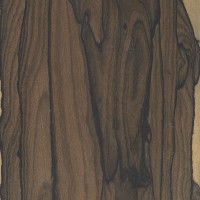 |
Common Name(s): Ziricote Scientific Name: Cordia dodecandra Distribution: Central America and Mexico Tree Size: 30-65 ft (10-20 m) tall, 2-3 ft (.6-1.0 m) trunk diameter Average Dried Weight: 50 lbs/ft3 (805 kg/m3) Specific Gravity (Basic, 12% MC): .65, .81 Janka Hardness: 1,970 lbf (8,780 N) Modulus of Rupture: 16,400 lbf/in2 (113.1 MPa) Elastic Modulus: 1,585,000 lbf/in2 (10.93 GPa) Crushing Strength: 9,270 lbf/in2 (63.9 MPa) Shrinkage: Radial: 3.5%, Tangential: 6.7%, Volumetric: 9.8%, T/R Ratio: 1.9 |
Color/Appearance: Color ranges from medium to dark brown, sometimes with either a green or purple hue, with darker bands of black growth rings intermixed. Ziricote has a very unique appearance, which is sometimes referred to as “spider-webbing” or “landscape” grain figure. Quartersawn surfaces can also have ray flakes similar in appearance to those found on quartersawn Hard Maple. The pale yellowish sapwood is sometimes incorporated into designs for aesthetic effect, or to cut down on wastage.
Grain/Texture: Grain is straight to slightly interlocked. Medium to fine texture, with good natural luster.
Endgrain: Diffuse-porous; solitary and radial multiples; large to very large pores in no specific arrangement, few; tyloses occasionally present; parenchyma vasicentric, confluent; wide rays, spacing normal to wide.
Rot Resistance: Ziricote is reported to be naturally resistant to decay.
Workability: Overall, Ziricote is fairly easy to work considering its high density. The wood tends to develop end and surface checks during drying, which can be problematic: though the wood is stable once dry. Also, pieces are usually available in narrow boards or turning squares, with sapwood being very common. Ziricote turns and finishes well, and in most instances, it can also be glued with no problems. (On rare occasions, the wood’s natural oils can interfere with the gluing process.)
Odor: Ziricote has a mild, characteristic scent while being worked, somewhat similar to the smell of Pau Ferro.
Allergies/Toxicity: Ziricote has been shown to cause cross reactions once an allergic sensitivity to certain woods has been developed. Woods that can cause initial sensitivity include: Pau Ferro, Macassar Ebony, Cocobolo, and most rosewoods. See the articles Wood Allergies and Toxicity and Wood Dust Safety for more information.
Pricing/Availability: Likely to be quite expensive, exceeding the price of some rosewoods, and approaching the cost of some types of ebony. Also, planks of Ziricote commonly have varying amounts of pale sapwood included, which can contribute to high wastage if not incorporated into a project.
Sustainability: This wood species is not listed in the CITES Appendices or on the IUCN Red List of Threatened Species.
Common Uses: Furniture, veneer, cabinetry, gunstocks, musical instruments (acoustic and electric guitars), turned objects, and other small specialty wood items.
Comments: A truly unique-looking wood, Ziricote has very few imitators; perhaps only the occasional piece of figured Brazilian Rosewood exhibits the same spider-webbing grain figure.
Scans/Pictures: A special thanks to Steve Earis for providing the turned photo of this wood species.
 |
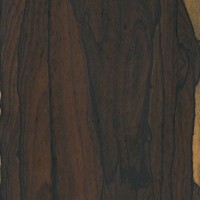 |
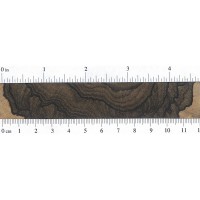 |
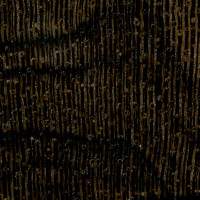 |
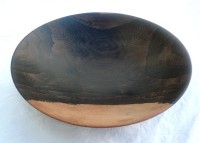 |





Is it pronounced ziri-coat or ziri-co-tay?
More like ziri-co-teh.
Regarding the Comments section about uniqueness, I believe the rare dark heartwood of persimmon (Diospyros virginiana and/or kaki) can display similar “spiderweb” patterns when it is wide enough in extremely old trees. Occasionally some olivewood will vaguely remind of the pattern as well.
We have made several acoustic guitars with this revered tonewood and have started a new project with back and sides made with this typically figured example .
I suppose there is a mistake in the hardness scale – I have ziricote, which I am unable to scratch with my fingernail. It’s definitely harder than 1.97. I think it has 2,97. Does anyone have similar observations?
Hard maple also can’t be easily scratched with a fingernail, and it’s hardness is only 1450 lbf. Using a fingernail is by no means an accurate way to measure hardness in the higher/harder tiers of hardwoods.
I can’t agree with that! The nail scratch resistance test is even mentioned in science books on wood; this is what anyone can do. This is a very good PRACTICAL test. Any wood from the Acer family can be scratched easily with a fingernail. It seems that you have very soft nails – not enough vitamins and minerals ;-) . Whether it is possible to make a mark on the wood with a fingernail is very important, especially when making small utilitarian, artistic objects or musical instruments. I have been professionally making oboes, flutes and clarinet mouthpieces for several decades.… Read more »
I think we are just referring to two different things, abrasion resistance versus resistance to indentation. Janka hardness measures the latter, hence the possible confusion. I misunderstood your initial post when you mentioned “fingernail scratch” since the “fingernail test” is something very commonly used when trying to tell hard and soft maple apart. But this test is technically one of indentation of your fingernail in the wood (which is quite difficult in hard maple). One’s ability to abrade the surface of the wood with a fingernail may be a different story, as you have been describing. But in terms of… Read more »
think it’s hardness though. I mark each of my instruments by embossing (pressing) a steel signature into the wood… And in this case Ziricote is quite hard compared to the given scale. Another idea came to me – maybe it’s a matter of specific samples that were tested. What was the humidity and whether they were dried naturally or artificially. It is very important. In my 30-year practice of making instruments, I have noticed that many exotic species (this is very clearly seen in Cocobolo!) change their properties unfavorably when kiln dried. Especially species that contain resins, fats or waxes.… Read more »
This is the back and sides Ziricote classical guitar. Outsanding sound. Looks amazing!
Hi, is it solid or laminated ziricote? I have seen a not so cheap Kala laminated baritone ukulele. Thanks.
This is a turnscrew made with ziricote and a tiny strip of ash that’s just visible. Finish is Ack’s Sanding Paste after sanding to 400 grit on the lathe. Brass and browned O-1 tool steel for the metals. For scale, the tip of the screwdriver fits a #4 wood screw perfectly.
Better Pic of Ziricote Drums
DW drums Ziricote
Just finished a hatchet handle with ziricote. It worked up beautifully.
This is the back side of a Kala ziricote ukulele. It is a gorgeous chocolate brown with distinct grain. The wood’s hardness brings a very fine rich tone to the instrument, with excellent sustain.
My neighbour turned a Ziricote fountain pen for my birthday – absolutely stunning! ithink one of the most beautiful pens I’ve ever seen. The photos I tried just show black, but its so much more than that
For darker pieces, sometimes the exposure on phone cameras can be thrown off and underexpose the image. Maybe try placing the pen on a darker backdrop and see if the details come out, would be interested to see a picture.
Thank you Eric, your advice worked! The gold has become a little overexposed but the wood grain is better than real life! As I understand it, once the turning is complete, many coats of super glue is applied at high revs to achieve a very high gloss finish.
Thanks for sharing!
I just acquired a 5ft x 2ft x 4in live edge slab of ziricote. Not sure exactly what to do with it. Thinking of a coffee table. Open to suggestions.
This is one of the most beautiful woods I have ever made anything with. It is unbelievable hard. I had an allergic reaction to it that had me break out in hives and cough for hours. Unfortunately it was worth it. I made a humidor for a good friend. With its dark brown (almost) black grain it contrasted with an Amercian cherry checker board very well.
Make a Acoustic guitar they sound stunning.
I have an Oskar Graf acoustic guitar with ziricote back and sides. Looks and sounds stunning as you say.
Turned Ziricote
Has anyone tried using Ziricote in the making of jewelry?
Hi Mimi. 2 years ago, but here’s to nothing. I’m making ear plugs from it as we speak, I’ll post the results in a day or two
Easier to work with than most rosewoods and ebony. Expensive – yes, but yields a nice product.
WARNING:
-This wood darkens with age when finished and lightens without finish.
-Easily the most expensive wood you can get your hands on.
-Disc sanders leave marks on the wood, especially the endgrain.
-Standard wood glue sticks out like a sore thumb when used with this wood.
-This wood is unbelievably dark, so any burns or scuffs will be easy to spot.
-If you already to this warning, chances are you have messed up in some way and want to try to find out what is wrong.
Do you think I can make cutting boards out of ziricote?
Yes.
piatti in ziricote fatti a Torino Italy
You can definitely fill in the voids, but don’t use yellow wood glue, use CA glue and sawdust.
Im building an ash bookcase and using Ziricote to make bookends. Ziricote is fantastic and contrasts nicely with the black ash. Does anyone have a recommended finish for it? The endgrain will be exposed (featured) and I’d like to preserve the color as it is. Polyurethane, varnish, lacquer, shellac, oils, wax????? Anything would help on brands would be great. As a note to anyone intending to work with it. It is very dusty, and the dust is somewhat sticky. The wood cuts cleanly and doesn’t seem prone to burn marks on a tablesaw….. but it is a bit of a… Read more »
I use Ziricote to build classical guitars and ukuleles. I finish them with shellac applied as French Polish techniques. I also spray it with nitrocellulose lacquer. Be careful when spraying nitrocellulose it is very explosive. You can also just fill the pores with a sanding sealer and just buff it with Caranuba wax. This is a very beautiful wood. I can suggest just about any finish. I would stay away from polyurethane because they seem to darken with age. I would suggest that you use only fresh shellac when applying the finish to the wood. Use only anhydrous alcohol if… Read more »
@d807f2928121401759ae5027b7ffc18e:disqus, Ziricote is strange, because unfinished pieces tend to lighten with age, developing a grayish-green patina on the exterior of the wood. Finished pieces, however, seem to slowly darken with age.
I frequently use Ziricote (Ciricote) for projects that are to have inlaid wood. Because of the darkness of Ziricote, almost any other wood contrasts well.
I own an octave mandola made by UK maker Andy Brown which has back and sides made in ciricote (the Mexican spelling for this Mexican tree). It not only looks stunning but has great tonal qualities. I also use it in my wood turning for things like lace bobbins and spinning spindles. It seems to darken a moderate amount with age.